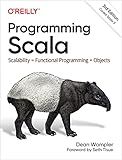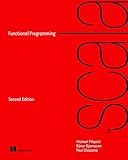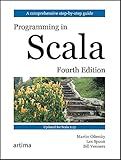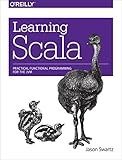Best Scala Programming Books to Buy in December 2025

Programming Scala: Scalability = Functional Programming + Objects



Functional Programming in Scala, Second Edition



Programming in Scala Fifth Edition



Hands-on Scala Programming: Learn Scala in a Practical, Project-Based Way



Programming in Scala



Functional Programming in Scala



Learning Scala: Practical Functional Programming for the JVM



Scala Cookbook: Recipes for Object-Oriented and Functional Programming


Implicit conversions in Scala allow for automatic conversion between types without the need for explicit conversion methods or functions. They are particularly useful for enhancing existing classes or libraries, extending their functionality, and providing a more intuitive interface.
To implement implicit conversions in Scala, follow these steps:
- Define an implicit function: Implicit conversions are achieved using implicit functions, which convert an object of one type into another. These functions are defined using the implicit keyword.
- Define the conversion: Write the implementation of the implicit function, specifying the source type as the input parameter and the target type as the return type. Within the function, perform the necessary conversions or transformations.
- Import the implicit conversion: Implicit conversions need to be in scope for the compiler to apply them automatically. To ensure this, import the implicit function either locally within a method or globally within a package or object.
Implicit conversions can be applied either directly or via implicit parameters. When an object undergoes an operation that is not defined for its type but is defined for the target type, the compiler will look for an implicit conversion function.
It is important to use implicit conversions judiciously to avoid confusion and maintain code readability. Overuse of implicit conversions may introduce unexpected behavior and make code harder to understand.
How to deal with potential ambiguity in implicit conversions in Scala?
To deal with potential ambiguity in implicit conversions in Scala, you can follow these guidelines:
- Be cautious with importing implicits: Avoid importing implicits from multiple sources when they can potentially conflict or create ambiguity. Only import implicits from specific places or packages when necessary.
- Use explicit type annotations: When you encounter ambiguity with implicit conversions, you can use explicit type annotations to explicitly specify the desired type. This will help the compiler to resolve the ambiguity correctly.
- Define more specific implicits: If you have multiple implicits that may apply to the same conversion, you can define more specific implicits. This will make it clearer which implicit conversion should be used in a given situation.
- Use implicit prioritization: If you have multiple implicits that could be used, you can define a higher-priority implicit explicitly by defining it closer to the usage site. The compiler will prioritize the implicit that is closer to the usage site over others.
- Wrap ambiguous implicits in an object or trait: To avoid implicit conflicts altogether, you can wrap the implicits in a separate object or trait. Then, you can selectively import the specific implicit that you want to use to resolve ambiguity.
- Rename or hide conflicting implicits: If you have implicits that cause ambiguity, you can rename or hide them by defining them in a different scope or object. This way, you can control which implicit conversion is used in a particular context.
Remember that while implicit conversions can be powerful, they can also introduce complexity and potential ambiguity. It is important to be aware of these possibilities and use the above guidelines to manage and resolve any potential ambiguity.
How to implement implicit conversions in Scala?
To implement implicit conversions in Scala, you can define an implicit function that converts from one type to another. This function should be defined either inside a package object or inside a trait/class/object.
Here is an example that demonstrates how to implement implicit conversions:
object ImplicitConversionExample {
// define a class Point representing a point in 2D space case class Point(x: Int, y: Int)
// define an implicit function that converts a Point to a String implicit def pointToString(point: Point): String = s"(${point.x}, ${point.y})"
def main(args: Array[String]): Unit = { val point = Point(1, 2)
// point will be implicitly converted to a String using the pointToString function
val pointAsString: String = point
println(pointAsString) // prints "(1, 2)"
} }
In the above example, the pointToString function is defined implicitly, which means the Scala compiler will automatically apply this conversion whenever required. In the main method, when point is assigned to pointAsString, the implicit conversion is triggered.
You can also define multiple implicit functions to enable multiple conversions between different types. However, if multiple implicit conversions are available, it can sometimes lead to ambiguity and compilation errors.
Note: Starting from Scala 2.13, implicit conversions are discouraged, and implicit classes are preferred for providing implicit conveniences. Implicit classes simplify the syntax and reduce the chances of ambiguity.
How to override implicit conversions in Scala?
In Scala, you can override implicit conversions by defining your own implicit conversion methods called "implicit classes" or "extension methods." Here's how you can do it:
- Define an implicit class or extension method: Create a new class or object that contains the conversion method. This method should take an argument of the type you want to convert and return the desired type.
implicit class MyConversion(value: Int) { def toCustomString: String = s"Value: $value" }
- Import the implicit class or object: In the scope where you want to use the conversion, import the implicit class or object.
import MyConversion._
- Use the conversion: Once the implicit conversion is in scope, you can use it as if it were a built-in conversion.
val number: Int = 42 val str: String = number.toCustomString println(str) // Output: Value: 42
By defining your own implicit classes or extension methods, you can override the default implicit conversions available in Scala. This allows you to customize how types are implicitly converted to other types.
What is the role of "canBuildFrom" in implicit conversions for collections in Scala?
The canBuildFrom method is a key component of implicit conversions for collections in Scala. It is part of the CanBuildFrom trait that defines a common pattern for creating new collections from existing ones.
The canBuildFrom method is responsible for providing a builder object that is capable of creating a new collection of the appropriate type. This builder is used during operations that transform collections, such as map, filter, and flatMap.
When a collection type A is transformed into a collection type B, the canBuildFrom method allows the conversion to happen seamlessly. It is used to implicitly convert between different collection types while preserving the statically known type information. This allows for concise and expressive collection transformations without explicitly specifying the target collection type.
For example, when calling the map or filter method on a collection, the canBuildFrom method is used to determine the builder that should be used to construct the resulting collection. This ensures that the transformed collection has the same type as the original collection, while allowing for different implementation types.
Overall, the canBuildFrom method plays a crucial role in enabling implicit conversions for collections in Scala, making it possible to seamlessly transform between different collection types without explicit type annotations.
What are some commonly used implicit conversions in Scala?
Some commonly used implicit conversions in Scala are:
- Numeric conversions: Scala provides implicit conversions between numeric types such as Int, Long, Double, etc. For example, you can convert an Int to a Double implicitly.
- String conversions: Scala provides implicit conversions between String and other types like Int, Double, etc. For example, you can convert a String to an Int implicitly using toInt.
- Collection conversions: Scala provides implicit conversions between different collection types, such as List to Set, Array to List, etc. This allows you to work with different collection types interchangeably.
- Date conversions: Scala provides implicit conversions between java.util.Date and java.time.LocalDate, making it easier to work with different date types.
- Option conversions: Scala provides implicit conversions between Option and other types, such as Some to Option, Option to Either, etc. This allows you to convert between different types that represent optional values.
- JSON conversions: Scala provides implicit conversions between JSON representations and case classes using libraries like circe, play-json, etc. This makes it easier to convert JSON data to and from Scala case classes.
Note: Implicit conversions can be powerful but can also introduce complexity and make code harder to understand. It is recommended to use implicit conversions judiciously and consider their impact on code readability and maintainability.
What is the scope of implicit conversions in Scala?
The scope of implicit conversions in Scala is limited to the compilation unit where they are defined, as well as the associated imports.
More specifically, implicit conversions are defined using the implicit keyword, and they are typically defined as methods or functions that take a single parameter and return a converted value. These conversions can be used to automatically convert an object of one type into another type when the context expects the latter type.
Within a compilation unit, Scala compiler looks for implicit conversions in the current scope and any imported implicit conversions. Scala provides some built-in implicit conversions, such as widening conversions between numeric types. Additionally, users can define their own implicit conversions or import them from other libraries.
It's important to note that implicit conversions can have a powerful impact on code readability and understanding. They can introduce unexpected behavior and make code more difficult to follow, so it's recommended to use them judiciously and with care.
